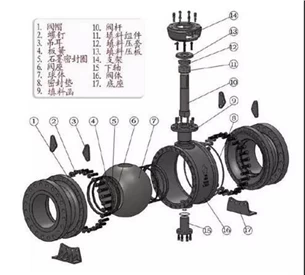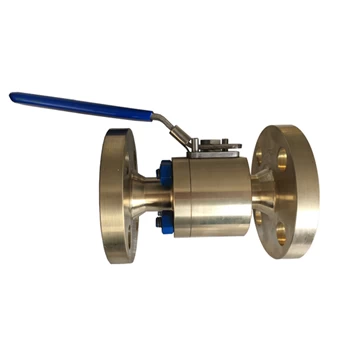Ball valve knowledge
The ball valve came out in the 1950s. With the rapid development of science and technology, the continuous improvement of production technology and product structure, in just 50 years, it has rapidly developed into a major valve category. In the developed western countries, the use of ball valves is increasing year by year.

The ball valve is mainly used to cut off, distribute and change the flow direction of the medium in the pipeline. It only needs to rotate 90 degrees and a small torque can be closed tightly. Ball valves are most suitable for use as on-off and shut-off valves.

Since the ball valve usually uses rubber, nylon and polytetrafluoroethylene as the seat sealing ring material, its use temperature is limited by the seat sealing ring material. The cut-off function of the ball valve is accomplished by pressing the metal ball against each other between the plastic valve seats under the action of the medium (floating ball valve). Under certain contact pressure, the valve seat sealing ring deforms elastically and plastically in some areas. This deformation can compensate the manufacturing accuracy and surface roughness of the ball, and ensure the sealing performance of the ball valve.

In addition, since the seat sealing ring of the ball valve is usually made of plastic, when selecting the structure and performance of the ball valve, the fire resistance and fire resistance of the ball valve must be considered, especially in the petroleum, chemical, metallurgical and other sectors, in the flammable and explosive media Ball valves are used in the equipment and piping system, and more attention should be paid to fire resistance and fire prevention.

Classification of ball valves
Ball valves are divided into: floating ball valve, fixed ball valve, orbital ball valve, V-shaped ball valve, three-way ball valve, stainless steel ball valve, floating ball valve, cast steel ball valve, forged steel ball valve, dust unloading ball valve, anti-sulfur ball valve, card sleeve ball valve, Welded ball valve.
Ball valve characteristics

1. Has the lowest flow resistance (actually zero).
2. It will not be stuck when there is no lubricant, so it can be reliably applied to corrosive media and low boiling point liquids.
3. 100% sealing can be achieved in a larger pressure and temperature range.
4. It can realize ultra-fast opening and closing, and the opening and closing time of some structures is only 0.05~0.1s to ensure that it can be used in the automation system of the test bench. When opening and closing the valve quickly, there is no shock in operation.
5. The ball closure can be automatically positioned in position.
6. The working medium is reliably sealed on both sides.
7. When fully open and fully closed, the sealing surface of the ball and the valve seat is isolated from the medium, so the medium passing through the valve at high speed will not cause erosion of the sealing surface.
8. With compact structure and light weight, it can be considered as the most reasonable valve structure suitable for cryogenic media systems.
9. The valve body is symmetrical, especially when the valve body structure is welded, which can well withstand the stress from the pipeline.
10. The closing piece can withstand the high pressure difference when closing.
11. The ball valve with fully welded body can be directly buried in the ground, so that the internal parts of the valve are not corroded, and the maximum service life can reach 30 years. It is the most ideal valve for oil and natural gas pipelines.
Applicable occasions of ball valve
The many unique characteristics of the ball valve determine the relatively wide range of applications of the ball valve. Generally, it is in two-position adjustment, strict sealing performance, mud, wear, necking passage, rapid opening and closing action (1/4 turn opening and closing), high pressure cutoff ( Large pressure difference), low noise, cavitation and vaporization, a small amount of leakage to the atmosphere, small operating torque, small fluid resistance, a ball valve is recommended.
Ball valves are also suitable for piping systems with light structure, low pressure cut-off (small pressure difference), and corrosive media. Ball valves can also be used in low temperature (cryogenic) devices and pipeline systems. In the oxygen pipeline system of the metallurgical industry, ball valves that have undergone strict degreasing treatment are required. When the main lines in the oil and gas pipelines need to be buried underground, full-diameter welded ball valves are required. When the adjustment performance is required, a ball valve with a special structure with a V-shaped opening should be selected. In petroleum, petrochemical, chemical, electric power, and urban construction, metal-to-metal sealed ball valves can be used for pipeline systems with operating temperatures above 200 degrees.

Principles of Ball Valve Application
For oil and natural gas transmission main lines, pipelines that need to be cleaned, and those that need to be buried underground, use full-diameter, full-welded ball valves;
Buried in the ground, choose full-diameter welded connection or flanged ball valve; branch pipe, choose flanged, welded connection, full-diameter or reduced diameter ball valve.
For the transportation pipeline and storage equipment of refined oil, use flanged ball valves.
For city gas and natural gas pipelines, use floating ball valves with flange connection and internal thread connection.
In the oxygen pipeline system in the metallurgical system, a fixed ball valve that has undergone strict degreasing treatment and flanged connection should be used.
For the piping system and device of low-temperature medium, a low-temperature ball valve with a valve cover should be selected.
On the piping system of the catalytic cracking unit of the oil refining unit, a lifter-type ball valve can be used.
In the equipment and piping system of corrosive media such as acid and alkali in chemical system, it is advisable to use all stainless steel ball valves made of austenitic stainless steel and PTFE as the seat and sealing ring.
Metal-to-metal sealing ball valves can be used on pipeline systems or devices for high-temperature media in metallurgical systems, power systems, petrochemical plants, and urban heating systems.
When flow adjustment is required, a worm gear driven, pneumatic or electric ball valve with V-shaped opening can be used.
Sea water valve will be selected with C95800 ball valve

Summary
The use of ball valves is very wide, and the variety and quantity of use continue to expand, and it is developing towards high pressure, high temperature, large diameter, high sealing performance, long life, excellent adjustment performance and multi-function of a valve. Its reliability and other performance indicators All have reached a high level, and can partially replace gate valves, globe valves, and regulating valves.
With the technological advancement of ball valves, in a foreseeable short period of time, there will be more extensive applications in oil and gas pipelines, crackers in oil refining, and the nuclear industry. In addition, ball valves will also become one of the leading valve types in large and medium-sized calibers and medium and low pressure fields in other industries.
 +86 512 68781993
+86 512 68781993 


















